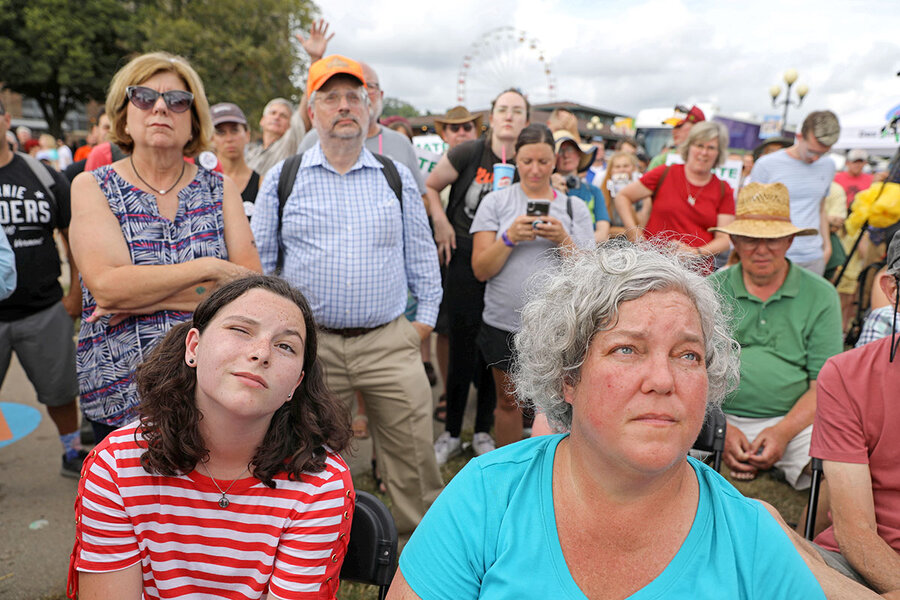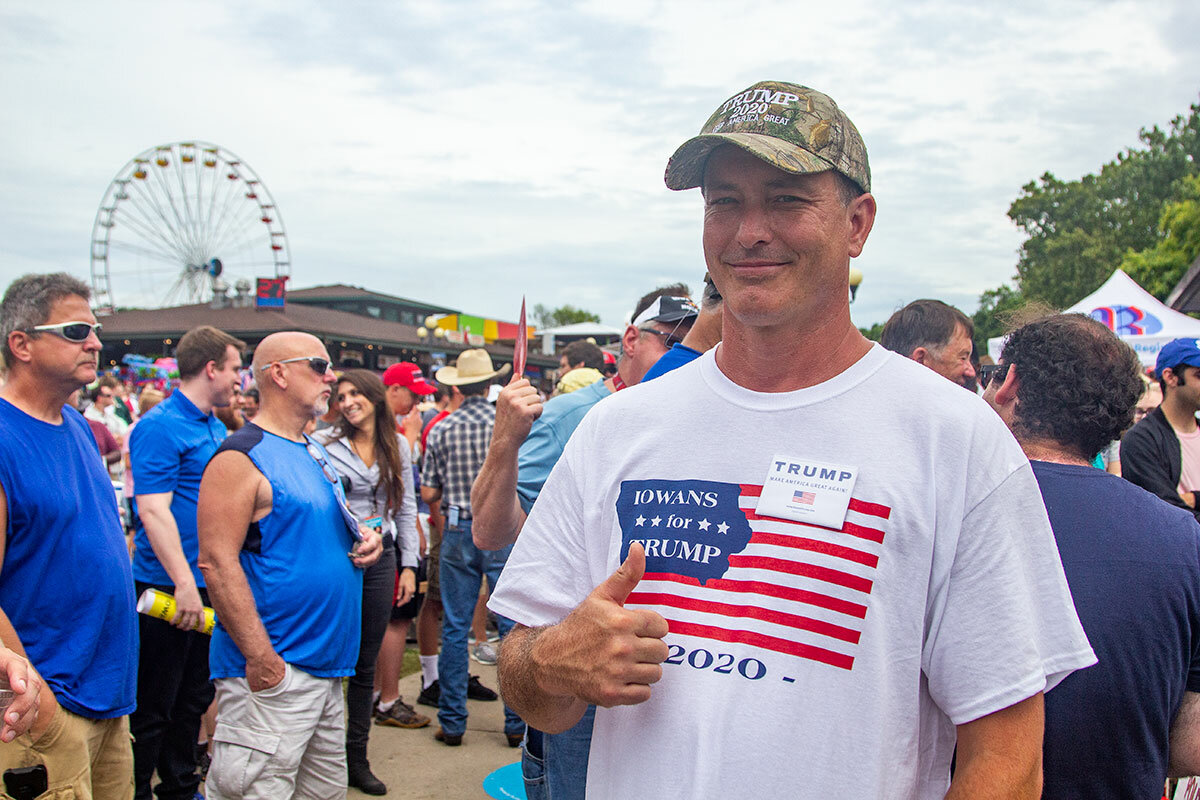Corn dogs and corn polls: Iowa’s brand of politics may matter more than ever
Loading...
| DES MOINES, IOWA
There are few places in America where in a single muggy morning you can encounter Christian evangelists, eat a deep-fried Oreo, and meet not only the Cow Chip Throwing Grand Champion but also possibly the nation’s next commander in chief.
But this is Iowa, the farm state that for nearly 50 years has played an outsize role in the presidential nomination process, with its first-in-the-nation caucuses. It is home to just 3.2 million people, many of whom manage to meet the candidates face-to-face as they traipse through rites of passage such as the “Wing Ding” dinner and the Iowa State Fair.
In truth, Iowa has a mixed track record when it comes to actually selecting presidents. Since Jimmy Carter rode a surprise victory in the caucuses here in 1976 all the way to the White House, only two others have followed suit (George W. Bush in 2000 and Barack Obama in 2008). But the state plays an undeniably pivotal role in winnowing the field: Placing lower than third here has proved fatal to nearly every campaign in modern history. And on the Democratic side, seven of the past nine winners in Iowa have gone on to secure their party’s nomination.
Why We Wrote This
A visit to the Iowa State Fair – a rite of passage for presidential contenders – highlights the Hawkeye State’s outsize influence in the nomination process, and the pivotal role it’s likely to play in winnowing the field.
Iowa’s voters are known for being thoughtful and taking their vetting role seriously. But it is the sixth-whitest state in the nation, which in recent years has led to growing complaints about the fairness of its influence, as America – and the presidential field – has become more diverse.
And so it has become a quadrennial question: Why Iowa? How did a state that has six times more pigs than people become the gatekeeper of the road to the White House – and should that be changed? That question takes on perhaps new urgency this cycle, when with less than a year to go until the national Democratic convention, there are still some two dozen candidates in the running.
“The bigger the field, the more important the caucus is,” says Dennis Goldford, a political science professor at Drake University in Des Moines and co-author of “The Iowa Precinct Caucuses: The Making of a Media Event.”
An electoral training ground
Political scientists and operatives in the state say there are good reasons for maintaining Iowa’s first-in-the-nation status. In an era of ever-costlier campaigns, its small size enables candidates with more modest budgets to get a foot in the door. That wouldn’t be possible in, say, California, where the outcome would be determined more by the number of ads a candidate could buy than how many hands they could shake at backyard events.
Those personal encounters benefit the candidates, too – they tend to emerge from their time in Iowa with a better honed message, says David Redlawsk, a political psychologist at the University of Delaware who is taking a sabbatical to study the caucuses in Iowa. “Candidates, if they’re going to get anywhere, get better by meeting people, talking to people, and learning from people,” says Professor Redlawsk, who hosted backyard meetings with candidates when he lived here a decade ago.
As for concerns about lack of diversity, many point out that the Democratic National Committee made an effort to address the issue back in 2008 by moving both Nevada and South Carolina – which include substantial Hispanic and African American voter populations respectively – up in the primary calendar. That same year, it was the mainly white voters of Iowa who launched President Barack Obama.
A standard stop for candidates is the Iowa State Fair, billed as one of the best if not the biggest state fairs in the country.
Over the course of 10 days, more than a million people come through to sample pork chops on a stick, ride the Ferris wheel, and gawk at the famous “butter cow” – a cow made entirely out of butter (and joined this year by butter “Sesame Street” characters). Presidential candidates are offered a soapbox on a busy corner to make their pitch.
“One of the great strengths of who we are as a nation and people is by our very nature we are aspirational,” declares California Sen. Kamala Harris from behind the hay bales. “We are a nation that was founded on noble ideals.”
Senator Harris’ “joyful fight” won the endorsement last week of Sue Dvorsky, the influential former chair of the Iowa State Democratic Party. People are looking for that kind of a fighter, says Ms. Dvorsky. “When she throws her head back and laughs in what are such dark times … that’s contagious.”
Ms. Harris has been conspicuously ramping up her presence in the state, including a massive bus painted with her first name. But polls show she’s still well behind former Vice President Joe Biden and Massachusetts Sen. Elizabeth Warren – who has invested heavily in staff here and is drawing perhaps the largest and most enthusiastic crowds.
At the state fair, attendees are invited to cast a kernel of corn for their preferred candidate. So far, the results are tracking pretty closely with official polls.
Critiques balanced with optimism
Speaking in the wake of back-to-back mass shootings, many of the candidates try to strike a balance between recognizing the gravity of the challenges facing the country and the perennial American desire to look ahead with hope and optimism. They criticize the president, while also seeking to present an alternative vision.
“We are the nation that beat the Nazis, [put a man] on the moon, and mapped the human genome. ... We are a country that did those things together,” proclaims Sen. Cory Booker of New Jersey, calling for a revival of civic grace. “This election is not about one guy and one office. It’s who we must be together.”
Jill Applegate from Des Moines asks Senator Booker about improving child care in the U.S. She says she prefers candidates who don’t just focus on the president.
“We know Trump is bad,” she says, holding a whirring purple and pink fan in front of her face to ease the muggy heat. “I’d rather hear more about what their plans are.”
Vermont Sen. Bernie Sanders, who can barely make his way through the fairgrounds thanks to a massive media mob, reminds supporters that all the things he said four years ago that were deemed “too radical” are now practically mainstream – and urgently needed.
“This is a monumental time in our country,” he thunders.
“Go Trump!” shouts a man sporting an “Iowans for President Trump” shirt.
“You’re a racist and a bigot, and you ...” says a lady nearby, trailing off.
The Trump supporter, Mike Duff, says he attended one of Donald Trump’s rallies ahead of the 2016 election and was inspired by his message, which he sums up as “Let’s be proud, let’s build our country up instead of giving it away. ... Let’s make the people around us successful.”
Today he’s part of a small group of pro-Trump folks standing around the soapbox – an effort to counter the intimidation he says they often feel from Democrats. These days, he says, many people are afraid to put out Trump yard signs, and when they do, they’re often ripped up.
“Get Trump out of there”
If there’s one thing Democratic voters agree on, it’s the need to oust the president.
“I would vote for a parakeet if they would beat Donald Trump,” says Mary Breiner, who’s visiting the fair from California, and says she has been horrified by what she sees as the president’s racism.
“As long as they get Trump out of there,” agrees Robert Piggee, an African American Vietnam veteran selling T-shirts on his lawn near the fairgrounds to raise awareness about veteran suicides. “We need the people of the U.S. to gel … and come together with a solution.”
But there’s a debate within the Democratic Party over the best way to beat Mr. Trump. Is it by courting moderates and working-class voters who feel alienated from a party increasingly dominated by coastal elites? Or by choosing a firebrand progressive like Senator Sanders or Senator Warren, who may inspire higher turnout among the party’s base, and motivate some who might not otherwise vote to head to the polls?
“People need to know us by how bold we’re going to be – otherwise they’re going to stay home,” says New York Mayor Bill de Blasio from the soapbox. “That’s what happened in 2016.”
“Really?” guffaws a lady walking by, laughing.
“We need to be for big, bold change,” Mayor De Blasio continues. “That’s how we energize people.”
Energizing people is key to Iowa’s system, which until this cycle required people to come out in person on a weekday evening and spend several hours caucusing with other voters. It’s not as simple as casting a ballot and getting an “I voted” sticker, as in primary states.
On the Republican side, it essentially functions as an anonymous straw poll. On the Democratic side, it’s far more complicated. Attendees are asked to show their preference for a candidate by assembling with other supporters in a corner of the room. Any candidate that does not meet a 15% threshold of support is considered “nonviable,” and their supporters must choose again. What emerges at the end of the night, at least until this cycle, is not a tally of votes but something called state delegate equivalents. (Editor’s note: This paragraph was updated to correct the term used for quantifying caucus results.)
“It’s a very wispy kind of measure,” says Professor Goldford. “I can explain quantum physics to you more easily.”
This year, the Democratic National Committee has added key changes – many pushed by Senator Sanders’ camp – to increase transparency and accountability. For the first time, raw numbers will be released showing voters’ first preferences before the nonviable candidates are weeded out. And a limited number of call-in opportunities will allow voters who can’t attend in person to indicate their ranked preferences for candidates.
“You have a big burden on your shoulders,” Minnesota Sen. Amy Klobuchar tells the crowd.
They know it – and they like it that way.
“We really savor the opportunity to do this,” says Tom Henderson, the former chairman of the Polk County Democrats. “Iowa voters aren’t arrogant about this. They take it as a great privilege.”







